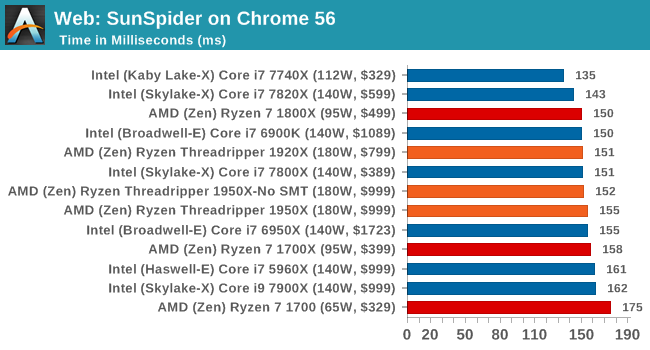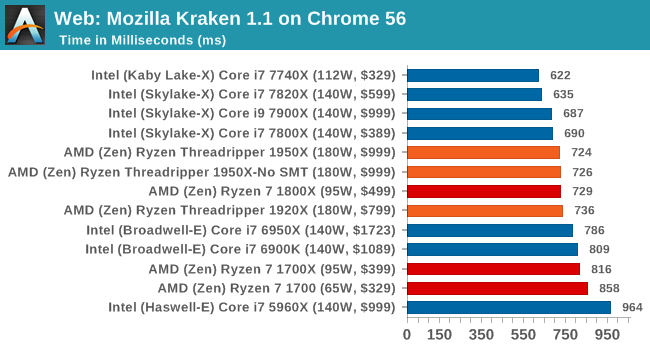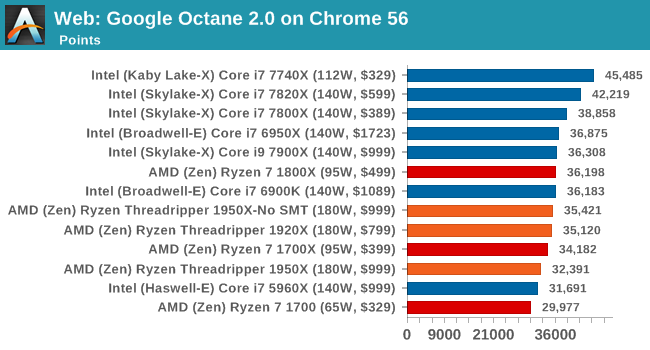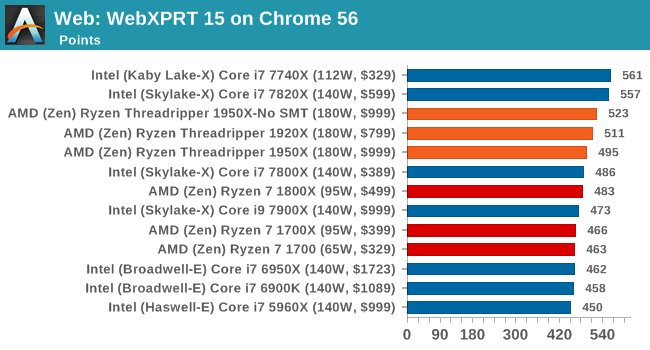The AMD Ryzen Threadripper 1950X and 1920X Review: CPUs on Steroids
by Ian Cutress on August 10, 2017 9:00 AM ESTCPU Web Tests
One of the issues when running web-based tests is the nature of modern browsers to automatically install updates. This means any sustained period of benchmarking will invariably fall foul of the 'it's updated beyond the state of comparison' rule, especially when browsers will update if you give them half a second to think about it. Despite this, we were able to find a series of commands to create an un-updatable version of Chrome 56 for our 2017 test suite. While this means we might not be on the bleeding edge of the latest browser, it makes the scores between CPUs comparable.
All of our benchmark results can also be found in our benchmark engine, Bench.
SunSpider 1.0.2: link
The oldest web-based benchmark in this portion of our test is SunSpider. This is a very basic javascript algorithm tool, and ends up being more a measure of IPC and latency than anything else, with most high-performance CPUs scoring around about the same. The basic test is looped 10 times and the average taken. We run the basic test 4 times.

Mozilla Kraken 1.1: link
Kraken is another Javascript based benchmark, using the same test harness as SunSpider, but focusing on more stringent real-world use cases and libraries, such as audio processing and image filters. Again, the basic test is looped ten times, and we run the basic test four times.

Google Octane 2.0: link
Along with Mozilla, as Google is a major browser developer, having peak JS performance is typically a critical asset when comparing against the other OS developers. In the same way that SunSpider is a very early JS benchmark, and Kraken is a bit newer, Octane aims to be more relevant to real workloads, especially in power constrained devices such as smartphones and tablets.

WebXPRT 2015: link
While the previous three benchmarks do calculations in the background and represent a score, WebXPRT is designed to be a better interpretation of visual workloads that a professional user might have, such as browser based applications, graphing, image editing, sort/analysis, scientific analysis and financial tools.

Overall, all of our web benchmarks show a similar trend. Very few web frameworks offer multi-threading – the browsers themselves are barely multi-threaded at times – so Threadripper's vast thread count is underutilized. What wins the day on the web are a handful of fast cores with high single-threaded performance.










347 Comments
View All Comments
Pekish79 - Friday, August 11, 2017 - link
Vraybench 1.0.5SanX - Friday, August 11, 2017 - link
*** AMD, make 2-chip mobos for upcoming multicore wars, you will double your profit from this at no cost for you +++vicbee - Friday, August 11, 2017 - link
Off subject: Having just read the article about nVidia's meteoric rise in profits, some of which directly attributed to high end "gamers" video cards purchased expressly for coin mining, I wonder if it and AMD are going to manufacture CPU's and GPU's specifically for that purpose and how that will affect the price of said parts...Avro Arrow - Friday, August 11, 2017 - link
Hi Ian, thanks for doing this article. It's important to see all possible outcomes because in the real world, anything is possible. I do have one question that has be puzzled. Why do you say that Threadripper only has 64 PCI-Express 3.0 lanes when it's been reported several times by everyone, including official AMD releases (and also including by you) that it has 64? I thought it might be just a typo but you state it in several places and in all of your specs. This is not a new thing so is there something about Threadripper that we don't know?HotJob - Friday, August 11, 2017 - link
Could someone explain to me what a "2P" system is from the competition section of the article?coolhardware - Saturday, August 12, 2017 - link
"2P" system = two processor system, i.e. a system with two physical CPU sockets and two CPUs installed.In the past a 2P (or 4P) system was really handy to get more cores especially back when 1 core, 2 core, and eventually 4 core CPUs were high end. In the consumer realm, way back, the Pentium II was the first 2P system I ever built and people even did it with Celerons as well:
http://www.cpu-central.com/dualceleron/
the Opterons were also fun for dual or quad processor systems including some SFF options like the ZMAX-DP socket 940 system.
https://www.newegg.com/Product/Product.aspx?Item=N...
Now fast forward with ThreadRipper already available at Amazon and NewEgg
http://amzn.to/2wDqgWw (URL shortened)
https://www.newegg.com/Product/Product.aspx?Item=N...
I do not think I will ever be building a 2P or 4P system again!!!
:-)
rvborgh - Friday, August 11, 2017 - link
hi Ian,i think the Cinebench 11.5 benchmarks are incorrect for both ThreadRippers. ThreadRipper is almost equivalent to my Quad Opteron (48 core) system which scores 3229cb on R15... and 39.04 on Cinebench 11.5. if i downclock all cores to approximately 2.9 GHz i end up with around 3000cb in R15 and in the 36 range point range for 11.5.
The fact that you are only scoring in the 18 range makes me wonder if you had the Threadripper set in some mode where it was only using 8 out of the 16 cores. Can you verify this... please? Thanks :) i would think you should see scores in the 36 range with 11.5.
Other than this minor detail... great article.
PS: i've had the same issues with software not liking NUMA on my quad opteron system as well... Cinebench especially does not like it.
Tchamber - Saturday, August 12, 2017 - link
Hi, Ian. Thanks for the review. As usual it was in depth and informative. I'm in the middle of building a 1700x system now based on your review. I wanted to say you handle all the nay-Sayers, gloomy Gusses and negative Nacies with aplomb! I think most people's own slant colors how they see your reviews. I appreciate the consistency of what you do here. I took a look over at Ars, and they could be called AMD shills for all the positive things they say... Keep it up!Tchamber - Saturday, August 12, 2017 - link
P.S.I loved your Kessel Run reference, it tied in nicely with your Yoda quote.
B3an - Saturday, August 12, 2017 - link
Too many plebs complaining about a lack of 3D rendering benches. The fact is a 16 core CPU is still much slower than GPU's at rendering. I'll be getting a 1950X but it wont even be used for rendering when i know for a fact that my two GPUs will still be much faster with things like Blender. Even a single high-end GPU will still easily beat the 1950X at these tasks.Seems like immature moron fanboys are crying over this stuff because they just want to see AMD at the top of the charts.